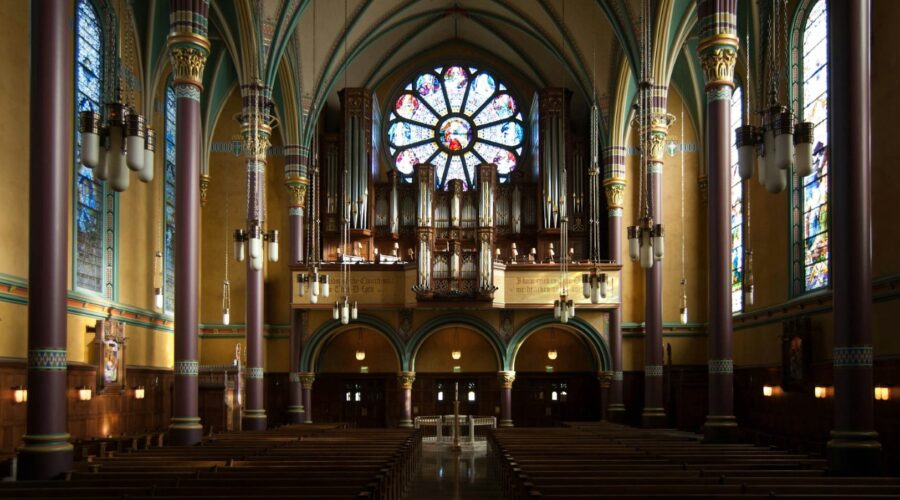Your cart is currently empty!
Explore the History, Beliefs, and Practices of the Catholic Church

Introduction
With over 1.3 billion members worldwide, the Catholic Church is the largest Christian denomination and one of the oldest and most influential institutions in human history. Its origins can be traced back to the teachings of Jesus Christ and the early apostles, and its beliefs and practices have evolved over centuries.
History of the Catholic Church
The Early Church
The Catholic Church traces its roots to the ministry of Jesus Christ and the establishment of the Christian community in the first century AD. The early Church was characterized by its emphasis on the sacraments, the authority of the apostles, and the importance of spreading the Gospel message.
The Rise and Fall of the Roman Empire
The spread of Christianity coincided with the rise and fall of the Roman Empire. While the Roman Empire initially persecuted Christians, it later adopted Christianity as its official religion. However, the collapse of the empire in the 5th century AD led to a period of instability and division within the Church.
The Middle Ages
During the Middle Ages, the Catholic Church emerged as a major force in Europe. It established monasteries and universities, preserved ancient knowledge, and played a crucial role in shaping medieval society.
The Reformation
The 16th century Reformation, led by figures such as Martin Luther and John Calvin, challenged the authority of the Catholic Church and led to the establishment of Protestantism.
The Modern Era
The Catholic Church underwent significant changes in the modern era, including the Second Vatican Council in the 1960s, which sought to reform the Church and adapt it to the changing world. The papacy of Pope John Paul II from 1978 to 2005 was also a significant period of growth and renewal.
Beliefs and Teachings of the Catholic Church
The Trinity
The Catholic Church believes in the Trinity, which consists of God the Father, God the Son (Jesus Christ), and God the Holy Spirit. The three Persons are distinct but united in one essence and eternally coequal.
The Incarnation
The Catholic Church teaches that Jesus Christ is the Son of God who became human through the Incarnation. He lived a sinless life, suffered, died, and rose from the dead to save humanity from sin.
The Sacraments
The Catholic Church recognizes seven sacraments: Baptism, Confirmation, Eucharist, Penance, Anointing of the Sick, Holy Orders, and Matrimony. These sacraments are channels of God’s grace that mediate his presence and action in the lives of believers.
The Bible and Tradition
The Catholic Church holds the Bible and Tradition as authoritative sources of faith and morals. The Bible is the inspired Word of God, and Tradition is the living transmission of the apostolic teachings and practices.
Practices of the Catholic Church
Worship and Liturgy
Catholic worship revolves around the Eucharist, or Holy Communion, which is the central act of the Mass. Other important liturgical practices include the Liturgy of the Hours, the sacraments, and the veneration of saints and martyrs.
Prayer and Spirituality
Prayer is an essential part of Catholic spirituality. It includes personal prayer, communal prayer, and the use of devotional practices such as the rosary.
Hierarchy and Organization
The Catholic Church is governed by a hierarchical structure led by the Pope, who is the Bishop of Rome and the successor of Peter the Apostle. The Church is divided into dioceses and parishes, each with its own bishop or pastor.
Social Justice and Mission
The Catholic Church emphasizes the importance of social justice and the preferential option for the poor. It operates numerous charitable organizations and promotes peace and human rights.
Criticism and Controversies of the Catholic Church
Clergy Sex Abuse
The Catholic Church has faced significant criticism and controversy in recent years due to allegations of sexual abuse by priests and other clergy members. The Church has taken steps to address this issue, including implementing stricter reporting and screening procedures.
Women’s Ordination
The Catholic Church does not ordain women as priests, deacons, or bishops. This practice has been criticized by some Catholics and feminist groups.
Contraception and Family Planning
The Catholic Church teaches that artificial contraception is morally wrong. This doctrine has been challenged by some Catholics and family planning advocates.
Conclusion
The Catholic Church is a complex and multifaceted institution with a rich history and a profound influence on world culture. Its beliefs, practices, and organization have shaped the lives of millions of people throughout the centuries. While it has faced its share of criticism and controversy, the Catholic Church remains an important spiritual and social force in the world today.